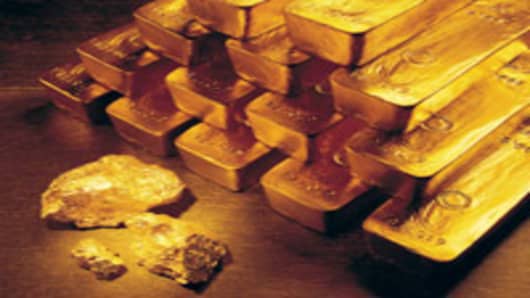In addition to the usual suspects, this week's stock market rally appears to have gotten help from an unlikely ally: commodities.
Whether it be gold, energy, grains or others in the space, a general rise in commodities has underlined a gain in demand and at least a scintilla of economic security that has restored confidence in equities.
"The constructive thing that we're seeing now is commodity prices are significantly higher," Art Hogan, managing director at Boston-based Jefferies, told CNBC. "That's important and energy as a whole is more important to the S&P than the financials are right now.
"We continue to see some strength out of both the consumer and the commodities, and we could have more legs to this rally than we've seen already." See Hogan's full commentary in video below.
As the stock market has risen 9 percent this week and major indexes were hanging around unchanged Friday, thanks primarily to a burst higher in banks, commodities have come along for the ride.
Crude oil prices, though somewhat volatile, have been flirting with $50 a barrel. Gold, which had been on an inverse path with stocks during the market's latest leg down, has risen five of the last seven sessions. Both silver and copper also have found themselves in a nice positive trend.
There's even some enthusiasm for grains, which took a beating after the ethanol craze peaked.
"I had my timing in for a bottom in the market for the last week of February and first week of March. I've been looking at being a buyer of commodities in general and that's been my timing for it," said Mark Schultz, chief analyst at Northstar Commodity in Minneapolis. "So far it appears to be working."
Yet Schultz warned that there will need to be more signs of economic recovery before he feels completely secure about the commodities trade. He's bought corn and soybeans but has held off from wheat pending further developments.
"There's a seasonal tendency to go in. I'm anticipating somewhere along the line there may be some weather scare," he said. "To have a sustained bull market it has to be demand-led. You have to stop liquidating who's buying your product."
Those gauging the commodities markets are looking at the Reuters/Jefferies CRB Index, which measures a basket of components and is off about 38 percent from a year ago but trending higher lately. The index was up 3 percent Thursday alone.
"We're actually starting to see some signals that these markets are turning around," said Darin Newsom, senior analyst at DTN in Omaha. "Much could be due to gold, but you're starting to see demand return in the copper market, gasoline, crude oil, and even the grains are trying to build this undercurrent of support."
Indeed, gold has been one of the big commodity stories during the market slump of the past four months, posting a 31 percent gain since its Nov. 13 low of $704.90.
"The fundamentals are incredibly supportive for gold," Evy Hambro, portfolio manager with BlackRock Investment Management, told CNBC. "We always encourage investors to have a little bit of the gold market from time to time. We think the quality investors will be here for the mid-term."
Commodity growth represents a reflation trend that analysts think will need to take place before the stock market recovers.
The recessionary economy finds itself in a negative-growth scenario that it will need to break out of before a long-term rally can be sustained.
"That's part of the reflation trade, and yes, you look at that," said Quincy Krosby, chief investment strategist at The Hartford. "At this stage you're looking at a mosaic trying to track global demand and look for the signs. Certainly the commodities, especially industrial commodities, is where you're looking for demand."
"You want to make sure you're not following what investors are doing," she added. "They're trying to create a rally out of nothing. You want to see the trend and you want to back it up with as much empirical evidence as you can with data coming out of various countries."
Oil also is looked at as one of the most reliable gauges for the direction of the global economy. Strong demand indicates growth, while the weak demand that has pervaded over the past six months has been a reliable indicator of economic contraction.
In the months ahead, Newsom sees crude breaking its range between $32 and $50 and hitting $70 by summer and the Organization of Petroleum Exporting Countries weighs whether to cut back on production.
"That's a very reasonable target for the summer," he said. "I don't think it's going to go much beyond that. We're going to see a limited rally, but a rally nonetheless in crude oil."
At the same time, hesitancy over the stock market also has analysts including Schultz and Newsom cautious about just how high commodities can run.
From 'Fast Money':
"I still think we're going to see another big leg down in the Dow and that could bring commodities down," Newsom said.
"I have been very pessimistic on the markets for a while, but I am coming away from that thought process for the short term," Schultz added. "It will be interesting if the Dow starts closing above 7,200 for the month of March."
To be sure, while this week's rally has given Wall Street some much-needed breathing room, there are few ready to abandon caution.
"Is this the beginning of a new bull market? That a bit difficult to say. It's probably not, but it can lead to a healthy bear market rally," Krosby said. "The underlying foundation for the rally was certainly oversold conditions. Technically it was probably so well-advertised that it wasn't a question of 'if' but 'when.' "



